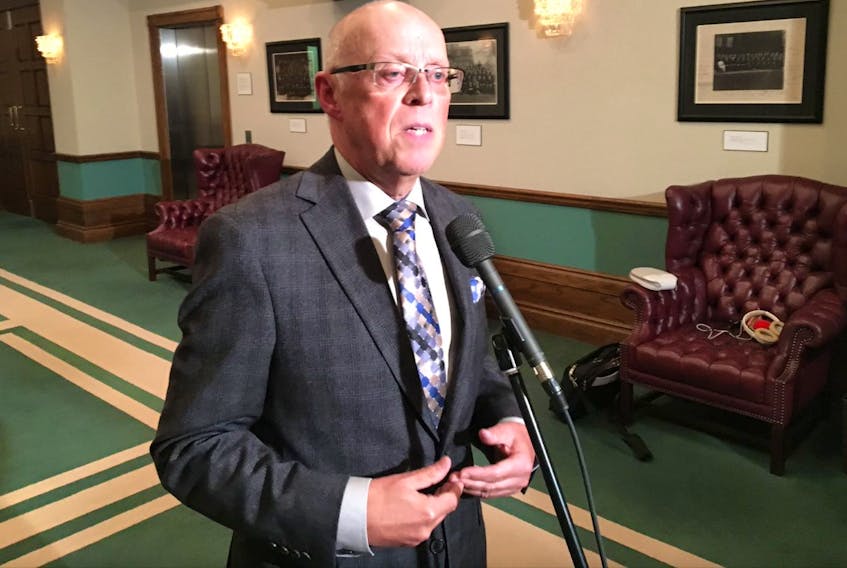ST. JOHN'S, N.L. — When it comes to per capita spending on health care, Newfoundland and Labrador continues to be the worst offender among the 10 Canadian provinces.
The data included in a Canadian Institute for Health Information (CIHI) report — "Health Expenditures in the Provinces and Territories" — released last month forecasts per capita health-care spending for Newfoundland and Labrador in 2019 to be $8,190 (public and private combined). That's the highest figure among all 10 provinces. The Canadian average is $7,068.
The same challenge has always been there for the provincial Health Department — the need to serve many residents in rural areas spread over a large geographical area.
"If you look when I first walked through the doors of the department in 2015, we had the highest (expenditures) per capita, and the rate at which it was increasing was matching everywhere else's," Health Minister John Haggie told The Telegram in a recent interview. "The challenge is trying to get that under control with no ill effects on services."
Haggie said Newfoundland and Labrador is doing better in that regard than it has in the past. For combined public-private per capita spending, Newfoundland and Labrador's growth rate of 1.6 per cent for 2019 was below the Canadian average of 2.9, and was the third-lowest among the provinces. At a strictly public level, provincial per capita health spending for 2019 is forecasted in the report to grow by less than 0.6 per cent. The five-year average for Newfoundland and Labrador from 2014-19 is 2.2 per cent, lower than comparable averages for 2010-14 (3.7) and 1996-10 (7.7).

"If we keep our expenditure the way we have done over the term of my two mandates, in about four years' time the cost lines between Newfoundland and Labrador and everywhere else will cross," Haggie said. "We will be in the middle of the pack, and we will do it by controlling expenditure at the same time as preserving the delivery of services."
Holistic approach
Dr. Patrick Parfrey, a professor in Memorial University's faculty of medicine who has done extensive research on health-care spending, says he is alarmed by the fact that for the amount of money the province continues to spend on health care, clinical outcomes in Newfoundland and Labrador have remained poor. He said the province must engage in a more holistic approach in dealing with how its health-care budget is spent.
"I think the decisions that are required to try and restructure the health-care system are very major," Parfrey said. "They impact on all localities. There's not much discussion about health care, and I do believe this problem needs to be dealt with by all the parties getting together, and the unions, in trying to come up with a strategic plan for health care for the province for the next decade, because all components of health care are interrelated, and a failure in one sector leads to problems in another sector."
Haggie says Newfoundland and Labrador's health-care system was operated for years with the mentality that by simply spending more money, health outcomes would improve.
"We have seen significant increases in expenditure up until 2015, and there's really been no change at all that we can measure in outcomes," Haggie said. "In actual fact, there's been challenges around access. Our physician services budget, for example, grows at a faster rate than most other areas of health care. It's outpaced only by drugs, really, and the emphasis we put on per capita community expenditure. So it's the third (highest), but we've seen a reduction in access rather than an increase in access."
Parfrey says there are too many acute-care services and not enough long-term care facilities to serve the province's aging population. In central and western Newfoundland, there are too many acute-care beds filled by patients who deserve to stay in a long-term care facility, Parfrey said.
In some parts of the province, there's a need for more primary-care services, collaboratives teams and emergency rooms empowered to stabilize and transfer patients to specialized facilities, he said.
"That would deliver a higher standard of care, with the acute specialized care being delivered in a smaller number of centres," said Parfrey, who also views unnecessary testing as an issue that needs to be addressed.
Increased spending to address the social determinants of health, such as poverty and education, would provide added help in lowering health-care spending, he added.
Smarter spending
These days, the Health Department has focused on finding ways to spend its budget in a smarter fashion. Haggie pinpoints the use of community services as one way the province has done this.
"These would be some reflection maybe of some of our hub initiatives where we're putting resources into the community rather than hospitals and putting them into front-line services rather than more expensive, high-tech stuff. I think the future of health care in this province is around community delivery."
"I think the future of health care in this province is around community delivery." — John Haggie
In western Newfoundland, a pilot project has paramedics visiting people in their homes to help monitor their health and avoid hospital visits. More than 1,300 patients in Newfoundland and Labrador have their chronic health conditions monitored remotely through electronic devices.
"Surprisingly enough, this hasn't been a challenge for the group you would think," Haggie said. "Seniors have taken to this technology and they're monitored by RNs centrally located, but these people never leave their homes."
The issue of serving an aging population remains a pivotal one, as the CIHI report shows the 65-74 age bracket has steadily accounted for more and more of Newfoundland and Labrador's health spending. It reached the 20 per cent mark in 2017. Today, that age group represents just about half of the baby boom generation.
"We are aging more rapidly than lots of other provinces, so certainly we're seeing numerically more of the boomers, and as you get older, traditionally your health-care needs do increase," Haggie said. "Having said that, there is some evidence that this boom generation will actually be the healthiest 65-year-olds that we've seen. It's not clear how much of an impact that's going to have on health-care demand."
Parfrey noted that in rural parts of the province, the senior population is increasing more rapidly, while fewer children are being born.
"We have services that are geared towards the children of the province, and we have no services that are geared towards the elderly of the province," he said.
Twitter: @CBNAndrew








